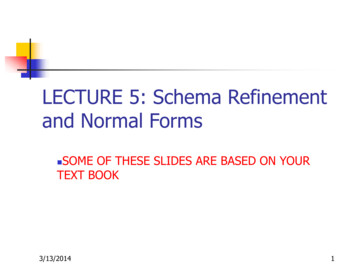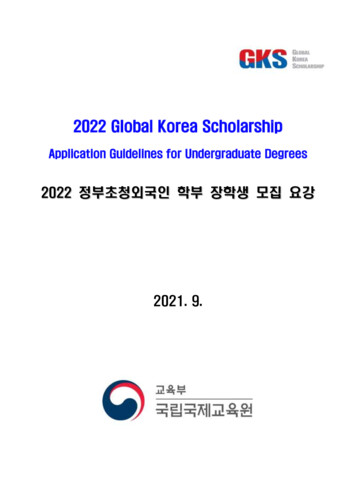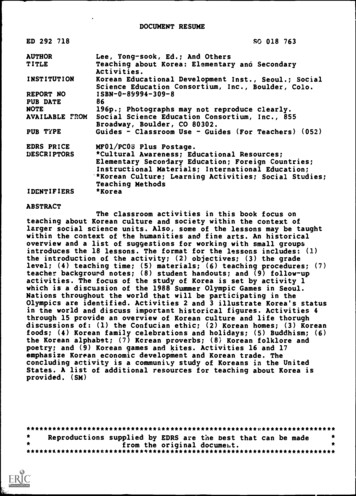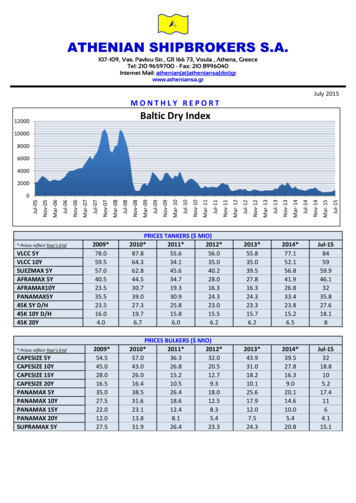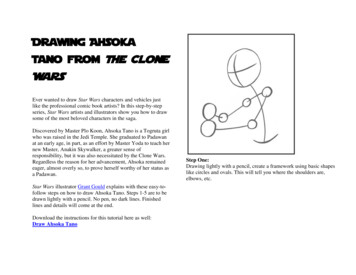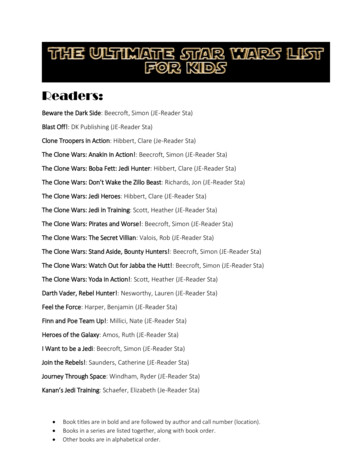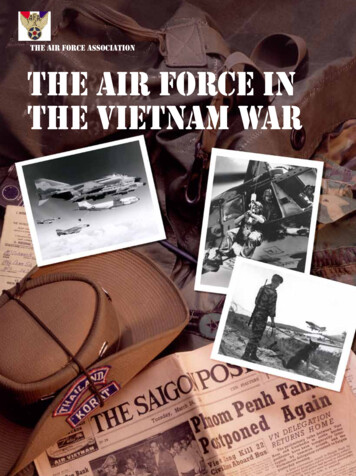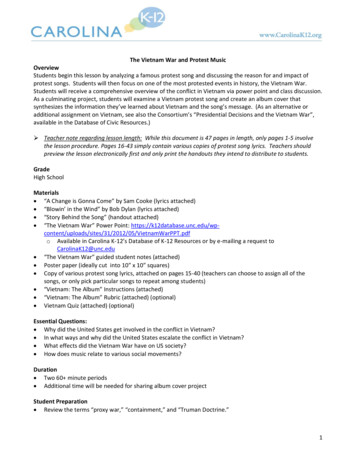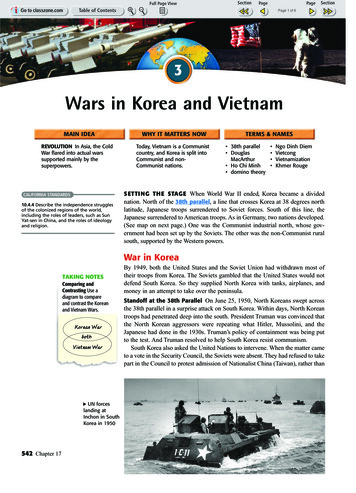
Transcription
Page 1 of 63Wars in Korea and VietnamMAIN IDEAREVOLUTION In Asia, the ColdWar flared into actual warssupported mainly by thesuperpowers.CALIFORNIA STANDARDS10.4.4 Describe the independence strugglesof the colonized regions of the world,including the roles of leaders, such as SunYat-sen in China, and the roles of ideologyand religion.WHY IT MATTERS NOWToday, Vietnam is a Communistcountry, and Korea is split intoCommunist and nonCommunist nations.TERMS & NAMES 38th parallel DouglasMacArthur Ho Chi Minh domino theory Ngo Dinh DiemVietcongVietnamizationKhmer RougeSETTING THE STAGE When World War II ended, Korea became a dividednation. North of the 38th parallel, a line that crosses Korea at 38 degrees northlatitude, Japanese troops surrendered to Soviet forces. South of this line, theJapanese surrendered to American troops. As in Germany, two nations developed.(See map on next page.) One was the Communist industrial north, whose government had been set up by the Soviets. The other was the non-Communist ruralsouth, supported by the Western powers.War in KoreaTAKING NOTESComparing andContrasting Use adiagram to compareand contrast the Koreanand Vietnam Wars.Korean WarbothVietnam War UN forceslanding atInchon in SouthKorea in 1950542 Chapter 17By 1949, both the United States and the Soviet Union had withdrawn most oftheir troops from Korea. The Soviets gambled that the United States would notdefend South Korea. So they supplied North Korea with tanks, airplanes, andmoney in an attempt to take over the peninsula.Standoff at the 38th Parallel On June 25, 1950, North Koreans swept acrossthe 38th parallel in a surprise attack on South Korea. Within days, North Koreantroops had penetrated deep into the south. President Truman was convinced thatthe North Korean aggressors were repeating what Hitler, Mussolini, and theJapanese had done in the 1930s. Truman’s policy of containment was being putto the test. And Truman resolved to help South Korea resist communism.South Korea also asked the United Nations to intervene. When the matter cameto a vote in the Security Council, the Soviets were absent. They had refused to takepart in the Council to protest admission of Nationalist China (Taiwan), rather than
Page 2 of 6RecognizingEffectsWhat effectsdid the Korean warhave on the Koreanpeople and nation?CHINA100 Miles0200 KilometersChineseIntervention,October 1950Ya0SOVIETUNION130 EThe Fighting Continues The UNWar in Korea,1950–1953125 ECommunist China, into the UN. As aresult, the Soviet Union could notveto the UN’s plan to send an international force to Korea to stop the invasion. A total of 15 nations, includingthe United States and Britain, participated under the command of GeneralDouglas MacArthur.Meanwhile, the North Koreanscontinued to advance. By September1950, they controlled the entireKorean peninsula except for atiny area around Pusan in the farsoutheast. That month, however,MacArthur launched a surpriseattack. Troops moving north fromPusan met with forces that had madean amphibious landing at Inchon.Caught in this “pincer action,” abouthalf of the North Koreans surrendered. The rest retreated.R.luChosanAntungUnsan40 NHungnamNORTHKOREA WonsanYellowS eaSe a o fJapanPyongyangPanmunjomInchonU.S. Marine StrikeSeptember 195038th ParallelSeoulSOUTHKOREAFarthest NorthKorean advance,September 1950Farthest UN advance,November 1950Farthest Chineseand North Koreanadvance, January 1951Armistice line, 1953TaejonPohangTaeguMokpoPusan35 Ntroops pursued the retreating NorthJAPANKoreans across the 38th parallel intoNorth Korea. They pushed themGEOGRAPHY SKILLBUILDER: Interpreting Mapsalmost to the Yalu River at the1. Movement What was the northernmost Korean city UN troopsChinese border. The UN forces werehad reached by November 1950?mostly from the United States. The2. Movement Did North or South Korean forces advance fartherChinese felt threatened by theseinto the other’s territory?troops and by an American fleet offtheir coast. In October 1950, theysent 300,000 troops into North Korea.The Chinese greatly outnumbered the UN forces. By January 1951, they hadpushed UN and South Korean troops out of North Korea. The Chinese then movedinto South Korea and captured the capital of Seoul. “We face an entirely new war,”declared MacArthur. He called for a nuclear attack against China. Truman viewedMacArthur’s proposals as reckless. “We are trying to prevent a world war, not startone,” he said. MacArthur tried to go over the President’s head by taking his case toCongress and the press. In response, Truman removed him.Over the next two years, UN forces fought to drive the Chinese and NorthKoreans back. By 1952, UN troops had regained control of South Korea. Finally,in July 1953, the UN forces and North Korea signed a cease-fire agreement. Theborder between the two Koreas was set near the 38th parallel, almost where it hadbeen before the war. In the meantime, 4 million soldiers and civilians had died.Aftermath of the War After the war, Korea remained divided. A demilitarizedzone, which still exists, separated the two countries. In North Korea, theCommunist dictator Kim Il Sung established collective farms, developed heavyindustry, and built up the military. At Kim’s death in 1994, his son Kim Jong Il tookpower. Under his rule, Communist North Korea developed nuclear weapons buthad serious economic problems. On the other hand, South Korea prospered, thankspartly to massive aid from the United States and other countries. In the 1960s, SouthRestructuring the Postwar World 543
Page 3 of 6Korea concentrated on developing its industry and expanding foreign trade. A succession of dictatorships ruled the rapidly developing country. With the 1987 adoption of a democratic constitution, however, South Korea established free elections.During the 1980s and 1990s, South Korea had one of the highest economic growthrates in the world.Political differences have kept the two Koreas apart, despite periodic discussionsof reuniting the country. North Korea’s possession of nuclear weapons is a majorobstacle. The United States still keeps troops in South Korea.War Breaks Out in VietnamMuch like its involvement in the Korean War, the involvement of the United Statesin Vietnam stemmed from its Cold War containment policy. After World War II, stopping the spread of communism was the principal goal of U.S. foreign policy.The Road to War In the early 1900s, France controlled most of resource-richSoutheast Asia. (French Indochina included what are now Vietnam, Laos, andCambodia.) But nationalist independence movements had begun to develop. Ayoung Vietnamese nationalist, Ho Chi Minh, turned to the Communists for help inhis struggle. During the 1930s, Ho’s Indochinese Communist party led revolts andstrikes against the French.The French responded by jailing Vietnamese protesters. They also sentenced Hoto death. He fled into exile, but returned to Vietnam in 1941,a year after the Japanese seized control of his country during World War II. Ho and other nationalists founded theVietminh (Independence) League. The Japanese wereforced out of Vietnam after their defeat in 1945. Ho ChiMinh believed that independence would follow, but Franceintended to regain its colony.Ho Chi Minh1890–1969When he was young, the poorVietnamese Nguyen That(uhng wihn thaht) Thanh worked asa cook on a French steamship. Invisiting U.S. cities where the boatdocked, he learned about Americanculture and ideals. He later took anew name—Ho Chi Minh, meaning“He who enlightens.” Though aCommunist, in proclaiming Vietnam’sindependence from France in 1945,he declared, “All men are createdequal.”His people revered him, callinghim Uncle Ho. However, Ho Chi Minhdid not put his democratic ideals intopractice. He ruled North Vietnam bycrushing all opposition.544 Chapter 17The Fighting Begins Vietnamese Nationalists andCommunists joined to fight the French armies. The Frenchheld most major cities, but the Vietminh had widespread support in the countryside. The Vietminh used hit-and-run tacticsto confine the French to the cities. In France the people beganto doubt that their colony was worth the lives and money thestruggle cost. In 1954, the French suffered a major militarydefeat at Dien Bien Phu. They surrendered to Ho.The United States had supported France in Vietnam.With the defeat of the French, the United States saw a risingthreat to the rest of Asia. President Eisenhower describedthis threat in terms of the domino theory. The SoutheastAsian nations were like a row of dominos, he said. The fallof one to communism would lead to the fall of its neighbors.This theory became a major justification for U.S. foreignpolicy during the Cold War era.Vietnam—A Divided Country After France’s defeat, aninternational peace conference met in Geneva to discussthe future of Indochina. Based on these talks, Vietnamwas divided at 17 north latitude. North of that line, HoChi Minh’s Communist forces governed. To the south,the United States and France set up an anti-Communistgovernment under the leadership of Ngo Dinh Diem(NOH dihn D’YEM).Making InferencesWhat actionsmight the UnitedStates have justifiedby the dominotheory?
Page 4 of 6War in Vietnam, 1957–1973CHINANORTHVIETNAMDien BienPhuHanoiHaiphongGulf ofTonkinImage not available for useon this CD-ROM. Please referto the image in the textbook.20 NHainanLAOSU.S. SeventhFleet, 1964VihnMek1965—U.S. bombing of North VietnamSouthChinaSeaDong HoiongR.HoDemarcationLine, 1954ihniMChHueDa NangTrailNChulai 15 Areas controlled in 1973National LiberationFront (Vietcong)Saigon governmentContested areasKon Tum1968—U.S. Marines at the Battle of Hue100 Miles0SOUTHVIETNAM0200 KilometersCAMBODIACam RahnBayPhnomPenhBien HoaSaigon10 N110 EGulf ofThailandMekongDelta1975—Evacuation of the U.S. embassy in Saigon1. Human-Environment Interaction Did the Saigongovernment or the Vietcong control more of SouthVietnam in 1973?2. Movement Through what other countries did NorthVietnamese troops move to invade South Vietnam?105 EGEOGRAPHY SKILLBUILDER: Interpreting Maps
Page 5 of 6Diem ruled the south as a dictator. Opposition to his government grew.Communist guerrillas, called Vietcong, began to gain strength in the south. Whilesome of the Vietcong were trained soldiers from North Vietnam, most were SouthVietnamese who hated Diem. Gradually, the Vietcong won control of large areas ofthe countryside. In 1963, a group of South Vietnamese generals had Diem assassinated. But the new leaders were no more popular than he had been. It appeared that atakeover by the Communist Vietcong, backed by North Vietnam, was inevitable.The United States Gets InvolvedFaced with the possibility of a Communist victory, the United States decided toescalate, or increase, its involvement. Some U.S. troops had been serving as advisers to the South Vietnamese since the late 1950s. But their numbers steadily grew,as did the numbers of planes and other military equipment sent to South Vietnam.U.S. Troops Enter the Fight In August 1964, U.S. President Lyndon Johnson told The skullsand bones ofCambodiancitizens forma hauntingmemorial tothe brutality ofits Communistgovernment inthe 1970s.Congress that North Vietnamese patrol boats had attacked two U.S. destroyers inthe Gulf of Tonkin. As a result, Congress authorized the president to send U.S.troops to fight in Vietnam. By late 1965, more than 185,000 U.S. soldiers were incombat on Vietnamese soil. U.S. planes had also begun to bomb North Vietnam.By 1968, more than half a million U.S. soldiers were in combat there.The United States had the best-equipped, most advanced army in the world. Yetit faced two major difficulties. First, U.S. soldiers were fighting a guerrilla war inunfamiliar jungle terrain. Second, the South Vietnamese government that they weredefending was becoming more unpopular. At the same time, support for theVietcong grew, with help and supplies from Ho Chi Minh, the Soviet Union, andChina. Unable to win a decisive victory on the ground, the United States turned toair power. U.S. forces bombed millions of acres of farmland and forest in anattempt to destroy enemy hideouts. This bombing strengthened peasants’opposition to the South Vietnamese government.The United States Withdraws During the late 1960s, the war grew increasinglyunpopular in the United States. Dissatisfied young people began to protest the tremendous loss of life in a conflict on the other side of the world.Bowing to intense public pressure, President Richard Nixonbegan withdrawing U.S. troops from Vietnam in 1969.Nixon had a plan called Vietnamization. It allowedfor U.S. troops to gradually pull out, while the SouthVietnamese increased their combat role. To pursueVietnamization while preserving the South Vietnamesegovernment, Nixon authorized a massive bombing campaign against North Vietnamese bases and supply routes.He also authorized bombings in neighboring Laos andCambodia to destroy Vietcong hiding places.In response to protests and political pressure at home,Nixon kept withdrawing U.S. troops. The last left in1973. Two years later, the North Vietnamese overranSouth Vietnam. The war ended, but more than 1.5 millionVietnamese and 58,000 Americans lost their lives.Postwar Southeast AsiaWar’s end did not bring an immediate halt to bloodshed andchaos in Southeast Asia. Cambodia (also known asKampuchea) was under siege by Communist rebels.
Page 6 of 6During the war, it had suffered U.S. bombing when it was usedas a sanctuary by North Vietnamese and Vietcong troops.Cambodia in Turmoil In 1975, Communist rebels knownas the Khmer Rouge set up a brutal Communist govern-ment under the leadership of Pol Pot. In a ruthless attemptto transform Cambodia into a Communist society, Pol Pot’sfollowers slaughtered 2 million people. This was almost onequarter of the nation’s population. The Vietnamese invadedin 1978. They overthrew the Khmer Rouge and installed aless repressive government. But fighting continued. TheVietnamese withdrew in 1989. In 1993, under the supervision of UN peacekeepers, Cambodia adopted a democraticconstitution and held free elections.RecognizingEffectsWhat was oneof the effects of PolPot’s efforts to turnCambodia into arural society?SECTIONVietnam after the War After 1975, the victorious NorthVietnamese imposed tight controls over the South. Officialssent thousands of people to “reeducation camps” for trainingin Communist thought. They nationalized industries andstrictly controlled businesses. They also renamed Saigon, theSouth’s former capital, Ho Chi Minh City. Communistoppression caused 1.5 million people to flee Vietnam. Mostescaped in dangerously overcrowded ships. More than200,000 “boat people” died at sea. The survivors often spentmonths in refugee camps in Southeast Asia. About 70,000eventually settled in the United States or Canada. AlthoughCommunists still govern Vietnam, the country now welcomes foreign investment. The United States normalizedrelations with Vietnam in 1995.While the superpowers were struggling for advantageduring the Korean and Vietnam wars, they also were seeking influence in other parts of the world.3Vietnam TodayVietnam remains a Communistcountry. But, like China, it hasintroduced elements of capitalisminto its economy. In 1997, a travelmagazine claimed that Hanoi, thecapital of Vietnam, “jumps withvitality, its streets and shops jammedwith locals and handfuls of Westerntourists and businesspeople.” Above,two executives tour the city.Along Hanoi’s shaded boulevards,billboards advertise U.S. andJapanese copiers, motorcycles, videorecorders, and soft drinks. On thestreets, enterprising Vietnamesebusinesspeople offer more traditionalservices. These include bicycle repair,a haircut, a shave, or a tasty snack.ASSESSMENTTERMS & NAMES 1. For each term or name, write a sentence explaining its significance. 38th parallel Douglas MacArthur Ho Chi Minh domino theory Ngo Dinh Diem Vietcong Vietnamization Khmer RougeUSING YOUR NOTESMAIN IDEAS2. In what ways were the causes3. What role did the Unitedand effects of the wars in KoreaNations play in the Koreanand Vietnam similar? (10.4.4)War? (10.4.4)Korean WarbothCRITICAL THINKING & WRITING6. ANALYZING MOTIVES What role did the policy ofcontainment play in the involvement of the United Statesin wars in Korea and Vietnam? (10.4.4)4. How did Vietnam becomedivided? (10.4.4)7. IDENTIFYING CAUSES How might imperialism be one of5. What was the Khmer Rouge’s8. FORMING OPINIONS Do you think U.S. involvement inplan for Cambodia? (10.4.4)Vietnam Warthe causes of the Vietnam War? (10.4.4)Vietnam was justified? Why or why not? (10.4.4)9. WRITING ACTIVITY EMPIRE BUILDING Write a two-paragraph expository essay for either the UnitedStates or the Soviet Union supporting its involvementin Asia. (Writing 2.3.a)CONNECT TO TODAY WRITING A BIOGRAPHYResearch the present-day leader of one of the countries discussed in this section.Then write a three-paragraph biography. (Writing 2.1.a)Restructuring the Postwar World 547
the 38th parallel in a surprise attack on South Korea. Within days, North Korean troops had penetrated deep into the south. President Truman was convinced that the North Korean aggressors were repeating what Hitler, Mussolini, and the Japanese had done in the 1930s. Truman's policy of containment was being put to the test.

